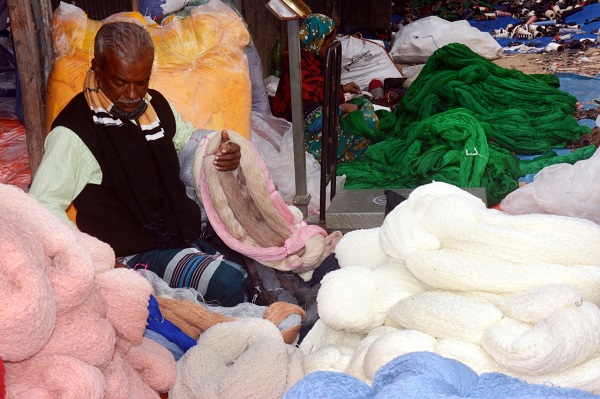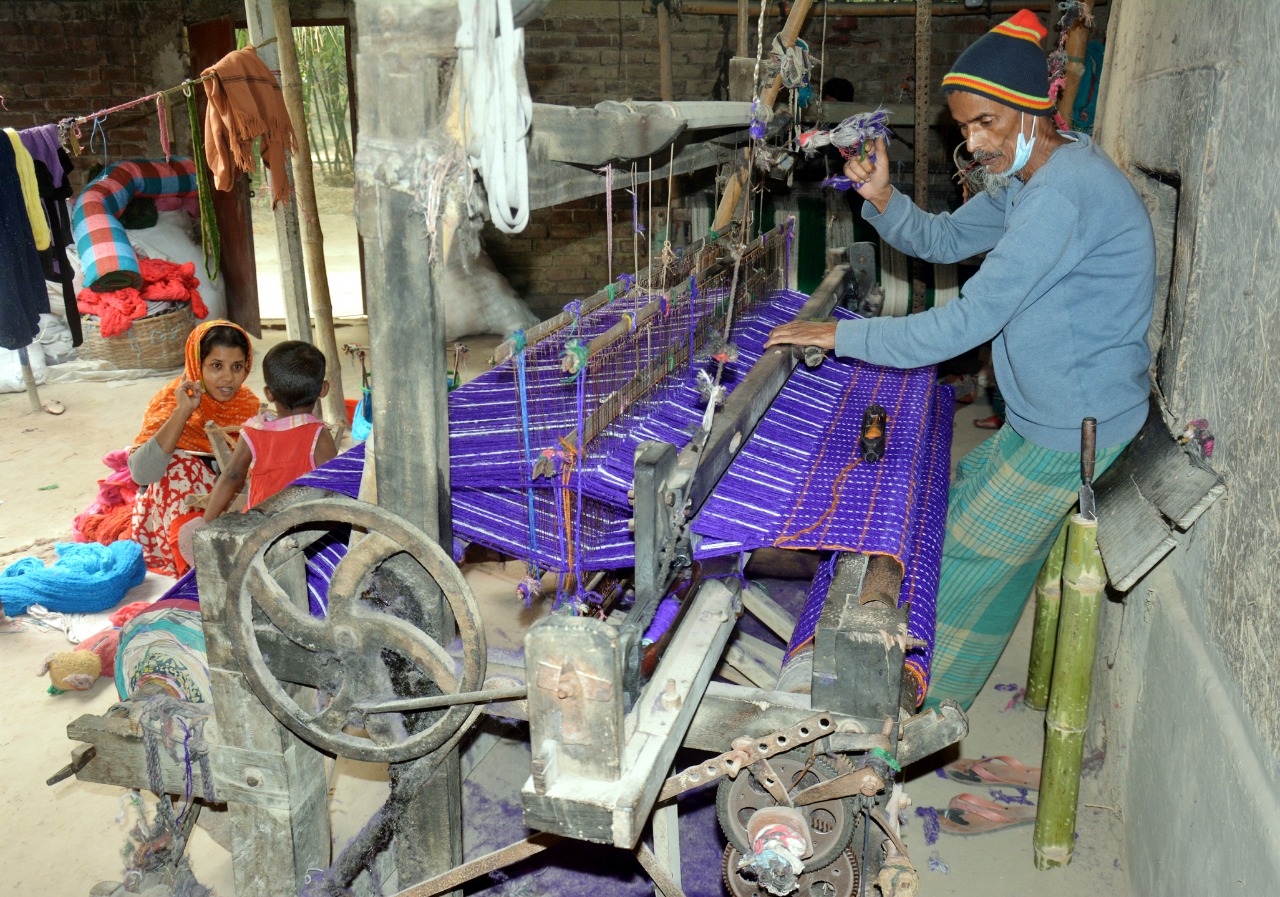Md. Anwar Hossain
The north wind is sending the winter message. As a result, the ‘Chadar Kambal village of Bogra’ has increased business. The demand for blankets and sheets increases as winter approaches. Everyone in the family, young and old, is now weaving. Despite the rising cost of manufacturing, the price of their lunar blankets has remained the same. Meanwhile, around the loom hamlet, ‘Shaol’s Hat,’ the country’s largest market for hand-woven blankets, has sprouted. Every day, wholesale buyers arrive from all across the country.
Their dream is accompanied by the sound of weaving and yarn weaving. The original work is a source of obsession for the residents of the surrounding villages, particularly Shawl. The sound of constant weaving and the bustle of people of various occupations, both men and women, fill the village surroundings. Someone is sitting at the spinning wheel, spinning yarn and lifting it onto the tube or needle. Someone is spinning the yarn.

Hand-woven looms constructed of bamboo wood are also available. Blankets, chandlers, mufflers, and bedcovers are all manufactured by weaving the yarns of different clothes’ sweaters. Cotton sheets, blankets, bedsheets, ladies sheets, lungis, towels, and towels are among the winter clothes woven by the weavers.
Although these garments are created all year in the district’s blanket villages of Adamdighi and Dupchanchia Upazilas, demand spikes in the winter, the community of Shawil produces the majority of the official winter blankets. Blankets range in price from 150 to 300 taka and from 100 to 450 taka, depending on the moon. Shawl’s market has approximately 1800 shops. On the Santahar-Bogra road, this hat and blanket community lies 35 kilometres north of Bogra and 4 kilometres north of Muril.
According to locals, this sheet is in high demand in Bangladesh since it is of such high quality, and these sheets are also sold in other areas of the world. In addition, various sweaters are also treated and woven into looms to make accessories like blankets and sheets. Without any marketing or participation, this vast workplace has expanded.
Business establishments for making winter garments, yarn, dyes, spinning looms, weaving machine tools, and late have all been built here, in addition to sheet manufacturing. Around the market, a slew of small and large stores have sprouted. Thousands of people work at retail stores. Bikini starts two days a week, from dawn to sunset, on Sundays and Wednesdays.
Hundreds of purchasers from across the country arrived the day before the market and took up residence in the merchants’ homes. After purchasing the products by demand, the buyers depart for their destination by 10 am.
According to the haat’s hazaradars, each heat sells blankets, sheets, and woollen yarn valued rupees. Hundreds of jobless persons have been hired all over the market. To buy sheets, blankets, and yarn, traders from all around the country, including the capital Dhaka, compete.
This headgear was manufactured in 1986 in Shawil village, Nasratpur union, Adamdighi Upazila. Additionally, the people of Adamdighi, Dupchanchia, Kahalu, Akkelpur, and Naongasdar Upazila in Joypurhatar district Naongasdar Upazila practise this vocation.
The weaving culture is still alive and strong among these North Bengal weavers. The Shawl is a small village in the Nasratpur union of the Bogra district’s Adamdighi Upazila. Several types of the hat were made in this village. They were buying and selling wool (woollen) yarn for original winter sheet blankets.
People have given this market the name “Chadar Kambal Hat Village” because of its age and popularity and the fact that chadar blankets are primarily bought and sold there. The market began at 4 am and ended at noon. On Sundays and Wednesdays, the market’s bars are open.
Furthermore, this market is open every day. Some 50 habits worth 50 crore taka are bought and traded during the winter. Although these hat shops and looms are available all year, business picks up as winter approaches. In addition, because everyone in the family participates, the manufacturing costs are cheaper.
Farhad Hossain, an HSC graduate, explained that they are all working in the family while cutting yarn in Charka. While schooling, he works closely with his parents.

Maqbool Hossain, 70, claims they have been weavers since their grandfathers’ time. He used to manufacture winter garments out of cotton yarn, but now he uses sweater yarn. He explained that the yarn from the garment’s rejected sweater was extracted and used to weave blankets and moons in the charakka. They also employ old garments and new wool yarns to produce winter clothes.
Shaheen, a weaver from Shaol village, said that they would buy yarn one day, dye it, dry it and process it, then weave it and make clothes.
Trader Ashraful Islam said most of those who distribute blankets among the winter goers go to the blanket market in Shawil village. Here, the leader sells eight cubits shawls long, which cost 500 to 600 taka, ladies moon 60 to 450 taka, winter clothes, and other moons.
Mofazzal Hossain, general secretary of the Shawl Hat and Market Committee, said he takes yarn from the lot, prepares the feti, or organises the yarn every day from 8 to 5 pm Buyers come from all across the country, including Dhaka and Chittagong, to purchase yarn.
Providing appropriate money to weavers and chances for healthy marketing and adequate raw material supply can revitalise the country’s weaving industry. However, despite rising production costs, he expressed dissatisfaction with the lack of price increases for moon-blankets and wanted government assistance, including bank loans.
Jahedul Islam, Deputy General Manager, BSCIC Bogra, has assured full support for the bank loan on easy terms.
Meanwhile, buyers go to buy winter clothes from different places across the country.

